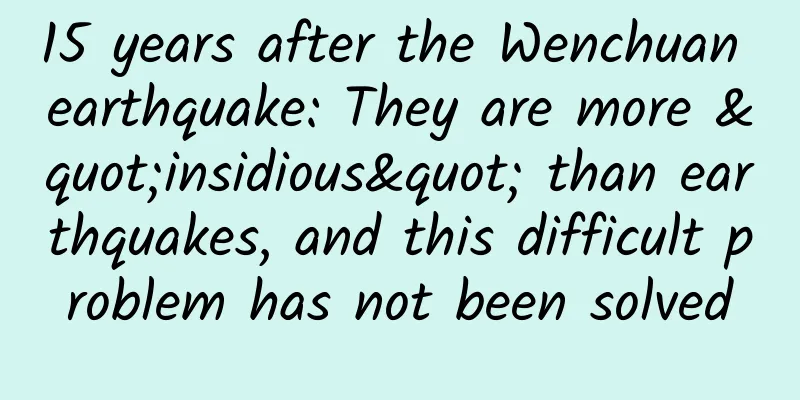15 years after the Wenchuan earthquake: They are more "insidious" than earthquakes, and this difficult problem has not been solved

|
We often lament the instantaneous power and destructiveness of earthquakes, but the geological disasters that have long lurked in the valleys after the earthquake may be the enemy we need to face in the long run. They are latent, hidden, sudden, mass, and chain disasters, and their harm is no less than the earthquake itself. ▲ Debris flow in Zoumaling Valley, Qingping, Mianzhu Sichuan is a region where geological disasters are relatively frequent, especially in the middle and high mountain canyon areas of western Sichuan where the Sichuan Basin and the plateau transition. The earth's crust is uplifted, rivers are cutting down, the terrain has great height differences, and the mountains are high and the slopes are steep. In addition, the region has a complex geological structure, frequent and strong earthquake activity, and intense neotectonic activity, which in turn leads to regional rock fragmentation and thick loose accumulation layers. In addition, the area is located in or close to the Huaxi Rain Screen, which is humid and rainy with heavy precipitation. All these factors are superimposed on each other, which is very conducive to the formation of geological disasters. In addition to enjoying the reputation of "Land of Abundance", Sichuan is also known as the "Museum of Geological Disasters". ▲ Sichuan's terrain characteristics make it prone to geological disasters Before the 5.12 Wenchuan earthquake, most of the research and prevention of geological disasters focused on their direct inducing factors and physical characteristics. For example, we usually divide geological disasters into four types: gravity type, rainfall type, artificial type, and composite type. In terms of type, they are also mainly divided into landslides, mud-rock flows, and collapses. ▲ Geological disaster prone areas in Sichuan Province After the 5.12 earthquake, we suddenly discovered that powerful forces acting on this special area had produced a large number of geological disasters that we were not very familiar with before. For example, there is a large number of geological disasters called "high-speed long-distance landslide-debris flow", which moves much faster than ordinary landslides. Due to the unusually high speed and long-distance displacement, the catastrophic accidents it causes are even more difficult to monitor and prevent. For example, in Niujuangou, Yingxiu, the epicenter, the landslide collided with the mountain several times and became debris, moving about 3.2 kilometers in the narrow valley, causing a large number of casualties. Another example is the Donghekou landslide in Qingchuan, where the debris flow moved as far as 2.4 kilometers, killing about 400 people. ▲ Qipangou debris flow Although research on this disaster began as early as the end of the 19th century, for more than 100 years, there has been no convincing theory to explain its high speed and ultra-long-distance displacement, let alone predict its disaster range. Some people call it one of the most mysterious phenomena in the geological world (Zhang Ming, Yin Yueping, etc., 2010). In addition, there is a high-altitude air-throwing landslide. During a strong earthquake, under the action of the strong horizontal earthquake inertia force, the rock mass on the upper part of the mountain is thrown out from a high position as a whole at a certain initial velocity, making a certain distance in the air, and then landing on the ground. During the movement, as its height decreases, its speed continues to increase, often reaching tens of meters per second, and its destructive power is extremely great. Today, in earthquake-stricken areas, we can still see dozens of landslides that are ejected at high speed and long distances and climb to the other side. ▲ Distribution map of geological disasters in Sichuan It can be said that the dynamic characteristics of the geological disasters induced by the Wenchuan earthquake have far exceeded the definition and understanding of traditional geological disasters under the action of gravity, such as landslides and collapses, in original science textbooks. After a strong earthquake, in addition to the large number of secondary geological disasters that will be triggered immediately, it will also cause large-scale loosening of the mountain and the formation of a large number of surface cracks. At the same time, the huge amount of materials formed by landslides and collapses after the earthquake will accumulate in the valleys and upstream of the slopes, just like burying time bombs. When the triggering conditions such as heavy rain are met, landslides and mudslides often break out simultaneously in a certain area, forming a disaster chain. On August 12-13, 2010, heavy rainfall hit the Sichuan 5.12 earthquake disaster area, and mudslides broke out almost simultaneously in 11 ditches in Qingping Township of Mianzhu City, Hongchun Ditch and its many tributaries in Yingxiu County of Wenchuan County, and about 50 ditches in Longchi Town of Dujiangyan. Their material sources were all triggered by the 5.12 earthquake. More than two years after the earthquake, the "hidden bombs" buried by these earthquakes were triggered one by one. They destroyed the post-disaster reconstruction results of the past two years in an instant with the force of thunder. The largest debris flow gully, Wenjiagou, was not originally a debris flow gully. It was because of the high-speed long-distance landslide-debris flow in Wenjiagou triggered by the 5.12 Wenchuan earthquake that accumulated an unusually rich source of loose materials upstream of the gully, which led to this huge debris flow. According to data, from 2009 to 2013 after the May 12 earthquake, Sichuan Province suffered 13,241 geological disasters, resulting in 683 deaths or disappearances and direct economic losses of 6.293 billion yuan. The loose deposits induced by the earthquake still have more than 10 billion cubic meters of deposits in the deep mountains and valleys, and the aftereffects of the Wenchuan earthquake will continue for more than 20 years. We often lament the instantaneous power and destructiveness of earthquakes, but the geological disasters that have long lurked in the valleys after the earthquake may be the enemy we need to face in the long run. They are latent, hidden, sudden, mass, and chain disasters, and their harm is no less than the earthquake itself. ▲ The huge mudslide in Jiagou almost buried Qingping Old Street -END- This article was published in the November 2017 issue of National Geographic China. Some of the information and opinions come from papers by experts such as Xu Qiang, Zhang Ming, and Yin Yueping. We would like to express our gratitude to them here! Content source: Xiake Geography |
>>: Southerners vs Northerners, who is fatter? The truth is...
Recommend
Humans are omnivores, so did our ancestors eat meat or vegetables?
Should people eat more meat or more vegetables? T...
How big is the Great Wall's "Secret Door Family"? This team draws a map
Over the past two thousand years, the Great Wall ...
The nicknames of the Winter Olympics venues are all about Chinese romance!
The "Water Cube" has been transformed i...
The most down-to-earth and profitable Feng Shui project, easily earning 30,000+ yuan a month, detailed explanation of Sanyuan Naqi Feng Shui
Target Group Feng Shui enthusiasts and practition...
Chengdu will have rainfall for 36 days in the next 40 days? You may not even check the weather forecast...
Yesterday Topic #Chengdu will have rainfall for 3...
Mycoplasma pneumoniae infection may peak in November: Parents must know these key questions
The health of children concerns every parent. Thi...
Apple iOS 15.1 Beta 3 has restored the ability to disable keyboard notifications for Apple TV and Apple Watch separately
[[428304]] According to 9to5 Mac, when the offici...
Three thoughts on live streaming operations
1. What does live broadcast operation do? Recentl...
Everything can be "hyaluronic acid"
The temperature dropped a while ago and I had a s...
You don’t know, these nine startups have been silently supporting your network behind the scenes
[[161777]] Granted, Amazon, Google, and Microsoft...
Excessive calcium supplementation is harmful! Many people have taken calcium supplements incorrectly over the years
Is the TV cabinet of your elderly also piled with...
Liu Guoliang, who bid farewell to table tennis, started a business, but what about the middle-aged employees of Dongfeng Peugeot Citroen Automobile?
January 10, 2018 was Liu Guoliang's birthday....
Rolls-Royce's first SUV official spy photos revealed
Recently, Rolls-Royce released two official spy p...
The latest news about Volkswagen Beetle is based on the MQB platform
Recently, foreign media reported the latest news ...









